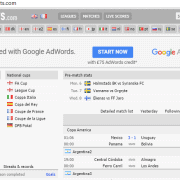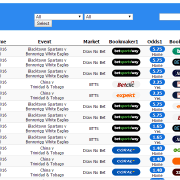Top Ten Horse Racing Tipsters
Here at Honest Betting Reviews we eagerly follow a large number of horse racing tipster in an effort to find the very best.
We scour all corners of the internet to try and find the most profitable ones – and not just the famous names that you see in the Racing Post but those who are less well known and who don’t necessarily have large marketing budgets to get their name out to the betting public.
What matters is whether they make money and if they are practical to follow – that is what we look for here on the site.
So you may be wondering, out of all the horse racing tipsters we have looked at, who are the best? Which ones should you consider putting your hard-earned cash towards following?
Well, here we put together our top ten list, starting with no.10 on the list and working our way up to the very best.
Top Ten Horse Racing Tipsters
So without further ado, here is our top ten list of the best horse racing tipsters around at the moment that you can follow.
Our ratings are based on a combination of looking at profit/loss, strike rate, return on investment, bet frequency and ultimately bank growth to determine the overall effectiveness of the tipster.
A large factor to consider is also practicality to follow – some tipsters may have very impressive records (like Hugh Taylor or Pricewise) but be impractical to follow as the tips get smashed in to such an extent that you would greatly struggle to make a profit from following them.
10. Morning Value Service
At number 10 is the Morning Value Service, which is run by a guy called Kieran Ward. It launched in 2011 and to date has made over 3,000 points profit – so that’s about 600 points per year on average.
The service has a high bet frequency, with 15-20 bets per day. The majority of these are sent out in the morning, with an update for the evening’s racing as well.
What we think is very interesting and impressive about the Morning Value Service – besides of course its amazing record of profit – is that you can actually still get good value at Betfair SP. In fact, during our trial we found that Betfair SP actually beat the advised prices, which is incredibly rare for a tipster.
That may be down in good part to the fact that Kieran limits the number of members – thus protecting prices.
It is quite expensive to join, at £320 for 3 months or £560 for 6 months, so you do need a reasonable bank of at least £2,000 we would say to make this worthwhile. But if you’ve got that kind of money it is definitely worth a look.
The service did endure a slightly tough second half of 2015 which is the only small minus point against it, but to be fair all tipsters are going to having small losing runs at some point and this one has otherwise been very impressive over a five year period.
9. Value Racing Tips
A highly consistent horse racing tipster, Value Racing Tips has been around since late 2013 and since setting up has made well over 400 points profit.
Following the tips at just £10 per point would have made you over £120 per month for the last two and a half years, which isn’t bad at all for a few minutes work per day.
All tips are simple 1 point level stakes, which is refreshing and means no crazy staking systems to inflate results as some tipsters do.
Prices are usually fairly obtainable, but even at Betfair SP we found during our trial a reduction of just 28% against advised prices, which is pretty reasonable.
A consistent record established over a good period of time, we are happy to include Value Racing Tips in our top ten list.
8. Tom Nelson Racing
Another high frequency betting service is Tom Nelson Racing, which comes from the highly respected Betting Gods stable.
The bet frequency isn’t nearly as high as the Morning Value Service and is more like 3-4 bets per day, but Tom’s record is very impressive as well, with just under 600 points profit accumulated since the service started tipping in June 2014.
That would work out at around £250 profit per month to just £10 stakes, which is a nice bit of extra cash in your pocket.
The service has managed a very respectable strike rate of just under 35% and there has amazingly been an 11-horse winning run for the service in the past.
The only small thing to note is that Tom’s return on investment isn’t quite as high as some of the other tipsters on this top ten list at 7%, but overall he is still a superb tipster and well worth his place here.
7. Profit Pony
Another top horse racing tipster is Profit Pony, which has built up a formidable total of over 1,000 points profit since starting up in 2014.
They have only had two losing months in that time, which shows remarkable consistency. Sadly our initial trial coincided with their worst month since starting the service, so we were only able to award a neutral rating. But we have continued to monitor things since our trial ended and results have improved considerably, with over 100 points being accumulated.
So bearing in mind the profits achieved before our trial and since, we think Profit Pony is deserving of a place on this list and would be a worthy addition to any betting portfolio.
6. Racing Gold
A tipster that made over 150 points during our trial and has made 500 points profit overall, Racing Gold is based out of the Tipster Street stable and has a solid following behind it.
The service seems to have really improved its form from May 2015 onwards, making 300 points in the year following that month.
This is another tipster with a good number of bets to follow, with an average of 4 tips per day. A healthy strike rate consistently in excess of 30% means a good amount of winning bets as well.
The return on investment is 8% over the long term, which is commendable given the high number of bets and good strike rate.
Things have stalled a little bit early in 2016 but we like to take a long-term view of tipsters and with over 500 points profit amassed, Racing Gold is a high quality tipster and one we would certainly recommend.
5. All Weather Profits
Originally seen as a poor relation of its more glamorous cousin flat turf racing, all-weather racing has grown and grown in recent years to become a force in its own right and is now a major focus of betting for a number of professional gamblers.
One of those is the All Weather Profits service from the Tipster Street stable. Betting only on the dirt, they have managed to secure profits of 500 points since setting up in early 2014.
Each year so far has shown over 100 points profit, which is no mean feat. That has been achieved with a strike rate of 22% and a decent return on investment of 13%.
Perhaps what is most impressive though is that all results are recorded at Betfair SP, which means you could well beat the recorded results using early prices and BOG bookies. Very few tipsters record results at Betfair SP, so given this and the excellent results achieved to date, we think All Weather Profits is a top class tipster and well worth following.
4. Russell Blair Racing
Russell Blair had a cracking live trial here on the site, racking up over 200 points profit over the 3 month trial.
Starting out life as a Twitter tipster, Russell now has his own website and since setting up the website in April 2015 he has amassed over 900 points profit, pretty incredible stuff.
Prior to that, Russell won 3 online tipping competitions, underlining his credentials as a top-class tipster.
There are generally 2-3 tips per day, sent out the evening before racing. Prices do often contract quite considerably before the off, evidenced by the difference between the results at advised prices and Betfair SP over our trial, with the latter being about 100 points lower.
Overall though this is first-class tipping service and one that we certainly think should be part of a betting portfolio.
3. Master Racing Tipster
The Master Racing Tipster is a service we originally reviewed back in June 2015 and gave a 5-star rating to at the time.
Their form continued to be excellent beyond the end of our trial up to the end of 2015, during which he amassed over 250 points profit over the calendar year.
That took the total profit accumulated since the service began in March 2014 to over 400 points, which is superlative stuff.
What is even more amazing though is that the profits came at a return on investment of over 40% – almost unheard of in horse racing tipping circles over such an extended period – and a very decent strike rate of over 30%.
Things have been a bit more tricky over the first half of 2016, but it has not been a disaster by any means, more a case of treading water for the Master.
Looking at the overall achievements, we think the Master Racing Tipster has compiled a superb record and is well worth a place high up on this list.
2. Racing Consultants
The Racing Consultants is a service run by two industry experts, Dave Massey and Rory Delargy. Now normally we avoid so-called “industry experts” like the plague, but these two did very well during our trial and have performed strongly since.
Over our three month trial they stacked up over 130 points profit – and the good news is that the results at Betfair SP were almost identical to those at advised prices, which is unusual for top horse racing tipsters.
Overall since setting up in June 2015, they have made over 500 points profit with an 18% return on investment, which is highly impressive.
We like the fact that they provide detailed analysis with their tips, so you know a lot of work has gone into them and there is sound logic behind the selections. Overall an excellent service and one we strongly recommend.
1. Quentin Franks Racing
Most tipsters are content with having just one tipping service. But when you’re as good as Quentin Franks, why not have two?
The main Quentin Franks Racing service has been running since June 2014 and in that time he has amassed just short of 500 points profit at a return on investment of 18%. A look at his profit graph shows a very steady and consistent return built up month-on-month over more than 2 years.
That would be impressive enough, but Quentin also supplements this with his evening service for the next day’s racing, QF Value Tips. This service has made 170 points profit at a return on investment of over 20%, meaning combining the two services gives you over 650 points profit at a return of around 20%.
Amazingly consistent stuff, two successful services and month-on-month profit lands Quentin Franks up at the top of our list. Highly recommended.
So there you have it, our top ten horse racing tipsters – the creme de la creme as they say! Hope you enjoyed reading this article and find these maestros bring you some gambling success. Whilst most of the tipsters on this page are paid tipsters, you may also want to check out our guide to free racing tips as well.














